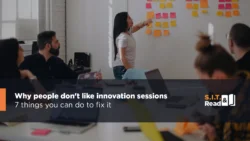Why people don’t like innovation sessions – 7 things you can do to fix it
I find that when you invite your coworkers to an innovation session you generally receive one of these responses:
- Amazing! Can’t wait to have a day to meet with passionate like-minded people and really crack this topic.
- If you can’t find anyone else…
- Can’t make it.
- (Radio silence).
The WSJ recently posted an article citing research that giving workers alone time could yield more innovation than getting everyone in a room.
For companies who really pride themselves on innovation (don’t we all?), why is there so much negativity to attend these sessions?
I think it boils down to what happens inside the session room, what happens before people enter the room, and what happens after people leave the room. When a session is prepared, executed and packaged properly, I fully believe that two heads are still better than one.
And so, here are seven tips on how to make your sessions worth people’s while, where they feel they can truly contribute to be agents of change:
- Define a clear goal and scope of the challenge, and make it clear to yourself, stakeholders and participants. If it’s too broad or large a topic, break it down into manageable nuggets otherwise people will be highly doubtful that anything can be accomplished in the timeframe (and annoyed if they were right). If the topic is smaller scale, maybe you don’t need to bring in the cavalry just yet and you can grab 3-4 folks to think it out with you.
- Plan and pick your time wisely and well: How much time do you really need for your session? Make sure your goals and deliverables match the time you have. If you have a full day, plan for it in a way that’s productive, and not dragged out. Everyone will always be happy to finish early. (In fact, I know an L&D professional who always plans innovation days to end an hour before the regular work day as a perk.) If you only have two hours, assess how your topic can be covered in this timeframe, and if not modify accordingly. Extra time you don’t need will make people feel resentful. Too little time on a big topic will make people feel like they haven’t scratched the surface and whatever time they did put in was for nought. Lastly, give some thought to the day of the week the session falls out on. A Thursday or Friday session could have people worrying about finishing other deadlines they have before the weekend, making them less than thrilled to participate.
- Make your innovation session walk the talk: An innovation session by name and definition is different from a regular business status meeting. The danger that lies in these sessions is when in an effort to stimulate creativity they become too gimmicky for anyone to take them seriously. Yet, if it is run in the same dry business-like manner as regular team meetings, it might not be terribly conducive to thinking in new unexplored directions. It’s a fine line to find the right methodologies that will give you the results you need, without making people in the room feel ridiculous, bored, or that they are oranges that need to be squeezed. Ask yourself – would I want to be doing this activity?
- Have the right (and the right amount of) people in the room: People are your number one resource. You need their knowledge, expertise, experience, and gumption. But how do you choose who should participate? First, build a heterogenous team that is familiar with the topic from different angles so ideas can be initially evaluated on the spot (without having to keep marking them “ask the guys from engineering” or “ask John” and everyone is frustrated why John isn’t here). This will help keep you on target with what can and cannot be done. Second, be realistic about the number of people and personalities you need for this topic and that you can handle. Too few, you may not get a rounded picture; too many can overwhelm the room and no one gets a word in if not managed properly. And last, mind the balance of the seniority level in the room. You don’t want people to be afraid of voicing their opinions in front of others and things are left unsaid.
- Menu: It is well known that I would do anything for a donut. Get your people fed! At the end of the day it’s these little things that we look forward to and make us feel appreciated. It’s also hard to think straight if you’re hungry, so set people up for success.
- Follow up and communicate – Set yourself a monthly reminder to update the participants how the project is doing. This will keep you accountable, all while showing your gratitude to the people who took time to participate. (You don’t want someone greeting you by the water cooler with whatever happened…?) When the project is implemented you can celebrate it. Should it get shelved, you can provide an explanation and what you’ve learned from it. People will appreciate hearing directly from you and not through the grapevine.
- Do some internal reflection: After the session, give yourself feedback on how it went. What went according to plan and what went less well than expected. Were you happy with the participants? Was the timeline realistic? What would you do the same in the future and what would you change?
Innovation sessions have so much riding on them to begin with. If you can get a group of fresh, eager, positive faces to participate, you’re halfway there already.










